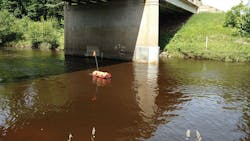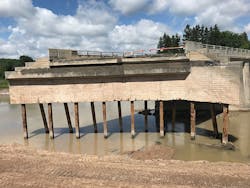Michigan monitors bridge scour with an ASCE “Gamechanger”
Michigan wants all of its bridges to be on solid footing.
In 2019, the Michigan Department of Transportation (MDOT) commissioned a study to look at various techniques to monitor bridge scour during high-flow events. Scour occurs when swift water flow from rain or snow melt erodes sediment away from the bridge substructure causing large holes to form, which in turn can cause undermining of footings and exposure of piles. Scouring is a leading cause of bridge failure.
The study was conducted by Ayres Associates, an architectural and engineering services firm based in Eau Claire, Wisconsin, under contract to the MDOT Research Administration. The study examined alternatives for monitoring and mitigating bridge scour, evaluating cost, performance specifications, sensors, data retrieval, processing and post-processing software, and quality.
The study, published in 2019, recommended using a remotely operated, sensor-equipped unmanned surface vessel (USV) to support MDOT’s bridge inspections. The study looked at sonars and unmanned surface vehicles, and recommended a combination of the Hydronalix Sonar EMILY (EMergency Integrated Lifesaving lanYard) USV equipped with the Humminbird sonar and SAR Hawk software.
According to Chad Skrocki, assistant bridge engineer for MDOT’s North Region, Michigan has about 400 state highway bridges and 1,200 crossings on local roads that MDOT engineers have identified as “scour critical.” There is periodic scheduled monitoring for the bridges, and more urgent inspections are conducted during high-water events, such as heavy rain, snowmelt, or a dam breach.
“Using the USV is much safer and less labor-intensive than traditional inspection methods for detecting scour,” said Skrocki. “Sonar EMILY provides a great deal of information in real time to the inspector about what is occurring to the channel bottom below the water surface around the bridge substructures. The preliminary inspections can become far more efficient, and if needed, we can use manned inspections to verify the things we’ve found with the USVs.”
Put right to work
The decision to procure Sonar EMILY was timely. In May 2020, Michigan experienced heavy rain and flooding that destroyed two dams and produced an accompanying path of destruction downstream that washed away boats, docks, cars, dumpsters, and debris. All downstream bridges were closed pending inspection. When those emergency inspections are most urgent, however, is when they are also more difficult and dangerous.
According to MDOT’s Jocelyn Hall, “We had several counties—Midland, Bay, Arenac, Iosco, and Saginaw—that were all declared to be in a state of emergency based on the flooding. While water levels were continuing to rise, we used EMILY to determine if scour was becoming increasingly worse in several locations, and once water levels stabilized, she was back in the water to confirm again that there were no scour critical issues that would need to be addressed ahead of opening a bridge to traffic.”
While each bridge might take up to a day to survey under a traditional inspection requiring equipment to be transported and assembled on-site, the MDOT team was able to inspect around one bridge per hour using EMILY.
EMILY was launched from a series of Navy-sponsored Small Business Innovation Research (SBIR) investments starting as far back as 2001. Sahuarita, Arizona-based Hydronalix CEO Tony Mulligan developed and extended the company’s technology, including EMILY, to provide multiple solutions to a wider array of problems. The small water-jet-powered apparatus is used for lifesaving and can reach people in distress faster than a swimmer or someone on a surfboard. The brightly colored buoys weigh just 25 lb and can travel at up to 22 miles per hour, and contain a two-way radio, a camera, and lights for night missions.
“EMILY is made of Kevlar and aircraft-grade composites and is virtually indestructible,” said Mulligan. “It can be thrown in the water, tossed off a boat or bridge, or dropped out of an airplane. The device has a tether so a swimmer in distress can grab it and be pulled to safety. It rescues people every day.”
Efficient, safe, and economical
Sonar EMILY is equipped with Humminbird fish-finding sonar from Johnson Outdoors Marine Electronics, using SAR Hawk software from Black Laser Learning Inc. (BLL) to process the data.
“The Humminbird sonar collects more information than it can display. Our software processes the data and [gives] the engineers the ability to properly display and review the data under controlled conditions with a high-resolution monitor,” said BLL CEO Vince Capone. “By displaying data in a post-processing environment, you can take advantage of that in full resolution.”
The system includes the USV with the installed sonar, a ground station to receive and record the data, which is uploaded to the computer with the software and which in turn allows the engineer to analyze and display the data on a geographically referenced chart or satellite image to give the engineer a documented data set. The Sonar EMILY side-scan sonar creates an image while it also collects single-beam bathymetry.
“The software strips out that single beam bathymetry information to create XYZ data—the X and Y axes provides the position and the Z is the vertical component, so the engineers can use that data to understand how deep the scour is, or how much it changed from the previous survey. Without the software, that data is not accessible from the Humminbird data itself,” Capone said.
Capone said every state in the country has the requirement to inspect bridges: “Having been in the industry for over 30 years, I’ve used a lot of technology to solve this problem. Bridges are not all the same. There’s no one tool for every bridge in every state. Sonar EMILY is both innovative and very effective in shallow water during post-flood conditions where there is a potential danger to divers, and it has the characteristics that, in many conditions, make it the right tool.”
Some inspections are conducted with a sonar suspended from a boat. However, a boat requires a convenient place to launch, and can be difficult to utilize around smaller bridges in smaller waterways, especially in surging water. If divers are required, water visibility may be very low.
“Depending on the circumstances, there may not be time to mobilize a boat and a qualified crew with sophisticated sonar,” Capone said. “The advantage of EMILY is that it is small, lightweight, inexpensive, and rugged, and can be maneuvered in tight areas with very little training. You can launch it right from the shore and conduct an emergency inspection, and determine if you have a problem without putting anyone at risk.”
Clear imagery
According to Capone, EMILY in some cases outperforms human divers, because they are hampered by visibility issues that do not affect sonar. “Water clarity does not impair the imagery with EMILY,” he said. “It’s unaffected by turbidity. It provides clear imagery no matter how turbid the water.”
MDOT bought four Sonar EMILYs, which are deployed around the state, and they’ve trained about several dozen people to use them. After MDOT bought theirs, one of the companies working under contract for MDOT, Great Lakes Engineering Group (GLEG), bought one for themselves, which they use when they conduct bridge inspections for MDOT.
Casey Collings, an engineer and diver with GLEG, said Sonar EMILY provides valuable intelligence before the divers enter the water, especially when the water visibility is low. He said the divers can encounter a lot of junk in the water, from tree branches to refrigerators to cars.
“We want to get some reconnaissance of what is down there before we actually get in the water,” said Collings. “We don’t want to go in blind. If we’re going into murky water with zero visibility, EMILY helps us understand what we should be seeing. We can make out exactly what’s down there. You can’t put a dollar figure on the safety value. We may still have to dive, but now we know what we’re getting into. We save a lot of time. More importantly, it’s really important for diver safety.
“We normally don’t find a lot of serious issues with the bridges,” Collings said. “However, we’re good at finding what’s wrong.”
Collings said his team is looking at new and different ways to use Sonar EMILY: “We haven’t figured all the ways to trick it out, yet. But it’s very adaptable.”
Hydronalix CEO Mulligan said his company is working to make transportation departments in other states aware of the success that Michigan is having. Most recently, the Montana DOT has procured EMILY for scour purposes—and this year the American Society of Civil Engineers named Sonar EMILY one of its four Infrastructure Gamechangers for bridges, stating: “This technology leads to more detailed assessments of bridges to best determine what actions to take in repairing or maintaining the structures, while also keeping crew members safe.”




